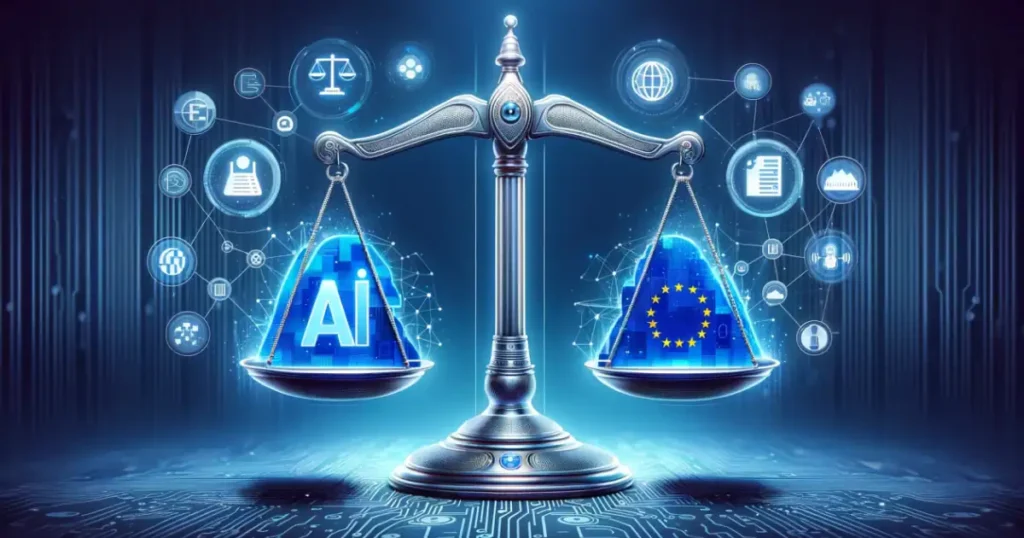As artificial intelligence (AI) continues to impact various industries, it’s crucial to involve humans in AI decision-making. Although AI can improve efficiency, it lacks moral understanding, which can lead to biased or unfair results. Without proper oversight, AI systems might make mistakes in vital areas like healthcare and finance or create safety risks.
Human oversight ensures that AI operates within ethical guidelines and reflects our societal values. By including human judgment in key decisions, organizations can enhance accountability, build trust, and reduce potential problems with automated AI systems.
The Importance of Human Oversight in AI
Human oversight in AI ensures ethical decisions and mitigates biases. While AI can process data rapidly, human involvement helps verify outputs, maintain accountability, and prevent harmful outcomes, especially in critical areas like healthcare and hiring.
Ethical Considerations: Ensuring AI Decisions Align with Societal Values
AI systems analyze large amounts of data to make decisions, but they do not have human morals or ethics. Without human oversight, AI can produce biased, unfair, or harmful results. For instance, AI hiring tools may favor certain groups because of biased training data. When organizations include human oversight, they can make sure AI decisions follow ethical standards, supporting fairness, inclusivity, and justice.
Risk Mitigation: Preventing Errors, Biases, and Unintended
AI can make mistakes, especially if it is trained on incomplete or biased data. In important fields like healthcare and finance, these mistakes can lead to serious issues, such as wrong medical diagnoses or unfair credit denials. To help prevent these problems, humans should review AI results. They can spot biases and make corrections before any final decisions are made. This approach reduces risks and makes AI more trustworthy.
Accountability: Establishing Clear Responsibility for AI-Driven Decisions

AI does not have personal responsibility, so it’s important to clearly define who is accountable for decisions made by AI. When AI systems fail or make mistakes, organizations need to decide who is responsible—developers, data scientists, or the businesses using the AI. Human oversight helps keep accountability clear and ensures that AI does not act without checks. By holding human operators responsible, companies can ensure that AI follows laws, ethical standards, and company policies.
The European Union’s Artificial Intelligence Act creates rules to regulate AI systems and stresses the need for human oversight, especially for high-risk uses.
EU Artificial Intelligence Act
The AI Act sorts AI systems into four categories: unacceptable, high, limited, and minimal risk. Each category has different rules that must be followed. High-risk AI systems, like those used in healthcare, transportation, and critical infrastructure, must meet strict requirements to ensure safety and protect people’s rights.
Overview of Article 14: Human Oversight for High-Risk AI Systems
Article 14 mandates that high-risk AI systems be designed and developed to allow effective human oversight. This includes implementing appropriate human-machine interface tools to enable users or other designated individuals to monitor the system’s operation and intervene when necessary. The goal is to prevent or minimize health, safety, and fundamental rights risks arising during the AI system’s use.
Requirements for Meaningful Human Involvement
The Act specifies that human oversight should be tailored to the intended purpose of the AI system and the specific risks it poses. Oversight mechanisms may involve:
- Manual Control: Allowing human operators to intervene and override AI decisions when necessary.
- Real-Time Monitoring: Enabling continuous supervision of the AI system’s performance to detect anomalies or deviations.
- Post-Decision Review: Implementing procedures for humans to review and, if needed, reverse or alter decisions made by the AI system.
These measures ensure that AI systems operate under meaningful human control, maintaining accountability and safeguarding fundamental rights.
Case Study: AI in Healthcare Diagnostics

In the healthcare sector, AI systems assist in diagnosing diseases by analyzing medical images. A notable example is the use of AI algorithms to detect diabetic retinopathy in retinal images. While these systems can enhance diagnostic accuracy, they are not infallible and may produce false positives or negatives. To mitigate risks, healthcare providers implement human oversight mechanisms, where medical professionals review AI-generated diagnoses before finalizing treatment plans. This approach ensures that AI is a supportive tool, with human experts making the ultimate decisions, safeguarding patient health, and upholding ethical standards.
Methods of Implementing Human Oversight
Organizations must integrate human oversight mechanisms to ensure AI systems make ethical and responsible decisions. Two key approaches are Human-in-the-Loop (HITL) systems and Explainable AI (XAI). These methods help maintain control over AI-driven processes, ensuring accountability, accuracy, and transparency.
Human-in-the-Loop (HITL) Systems
HITL systems involve human intervention at crucial stages of AI decision-making. Instead of allowing AI to function autonomously, humans review, validate, and override AI-generated decisions when necessary. This approach benefits high-risk fields where incorrect AI predictions could have serious consequences.
Examples of HITL Applications
- Healthcare: AI-powered diagnostics assist doctors in detecting diseases like cancer or diabetic retinopathy. However, medical professionals review final diagnoses before treatment decisions are made.
- Finance: AI algorithms detect fraudulent transactions, but human analysts validate flagged cases to reduce false positives and ensure accurate fraud detection.
By incorporating HITL systems, businesses can minimize errors and ensure AI aligns with ethical and regulatory standards.
Explainable AI (XAI)
Explainable AI (XAI) focuses on making AI decisions transparent and understandable. Unlike black-box AI models, which provide little insight into their reasoning, XAI ensures that users can interpret how and why an AI system arrived at a particular decision.
Benefits of XAI in Enhancing Trust and Oversight
- Improves Accountability: Organizations can trace AI decisions back to specific inputs, making it easier to detect biases or errors.
- Builds User Confidence: When AI models are explainable, businesses, regulators, and consumers can trust their decisions.
- Facilitates Compliance: Many regulatory frameworks, such as the EU AI Act, require AI decisions to be explainable, ensuring they align with ethical standards.
Challenges in Maintaining Effective Human Oversight
Human oversight is essential for ethical decisions in AI. However, there are challenges that make this difficult. These include the complexity of understanding AI models, concerns about how well this can scale, and the risk of depending too much on AI-generated advice. To ensure that AI supports human judgment rather than replacing it, we must address these challenges.
Complexity of AI Systems
Advanced AI models and complex learning algorithms often act like “black boxes.” This makes it hard for people to understand how they make decisions. Without clear explanations, even experts may not know why an AI system chose a particular option. To improve understanding, organizations should invest in tools that help explain AI decisions and frameworks that make the models easier to interpret.
Scalability Issues
Maintaining human oversight becomes increasingly challenging as AI systems process vast amounts of data and automate decisions at scale. Manual reviews of every AI-generated decision are impractical in finance, healthcare, and content moderation, where AI operates quickly. A hybrid approach—combining automated monitoring with human validation for high-risk cases—can help balance efficiency and oversight.
Potential for Overreliance on AI
AI is becoming more accurate and efficient, but this can make people overly reliant on it. When individuals trust AI recommendations without thinking critically, it leads to a problem called automation bias. This can reduce personal responsibility and create mistakes if AI systems fail or make incorrect predictions. Organizations need to teach AI literacy and foster a culture of questioning AI. It’s important for human experts to review AI outputs carefully instead of following them blindly.
Case Study: Boeing 737 MAX and Overreliance on AI
The Boeing 737 MAX crashes in 2018 and 2019 illustrate the dangers of excessive reliance on AI. The aircraft’s Maneuvering Characteristics Augmentation System (MCAS) was designed to correct the plane’s pitch automatically. However, due to faulty sensor data, MCAS repeatedly forced the plane into a nose-dive. Unaware of how the system worked, pilots struggled to override it, leading to catastrophic crashes. This case underscores the importance of human oversight, proper training, and ensuring AI decisions remain interpretable and controllable by humans.
Best Practices for Enhancing Human Oversight
Effective human oversight in AI requires regular audits, ensuring compliance and ethical alignment. Training programs equip personnel with the skills to monitor AI decisions critically. Establishing clear governance structures defines roles and responsibilities, ensuring accountability. These best practices help maintain transparency, reduce risks, and foster trust in AI-driven systems.
Regular Audits and Assessments
Regular checks of AI systems are important to find biases, errors, and compliance problems. Organizations should perform audits regularly to evaluate how well AI is working and to make sure it meets ethical standards. Independent audits and third-party reviews can improve transparency and accountability, helping to minimize the chances of harmful AI decisions.
Training and Education
Personnel must have the necessary skills to monitor, interpret, and intervene in AI processes for effective human oversight. Regular training programs should be implemented to educate employees on AI capabilities, limitations, and ethical considerations. This ensures that human supervisors can identify potential risks, challenge AI-driven conclusions, and apply critical thinking when reviewing automated decisions.
Establishing Clear Governance Structures
A clear governance framework is essential for assigning roles and responsibilities in overseeing AI. Organizations should create clear policies, procedures for raising issues, and accountability systems to define who monitors AI behavior and takes action when needed. Good governance helps ensure that AI supports business goals and follows ethical and legal standards.
The Future of Human Oversight in AI

As AI systems continue to evolve, so must the mechanisms for human oversight. Future developments will focus on enhancing supervision technologies, adapting regulatory frameworks, and ensuring continuous improvement in oversight strategies. These advancements will be critical in balancing AI autonomy with human control.
Advancements in Oversight Technologies
New tools and frameworks are being developed to enhance human supervision of AI systems. AI monitoring dashboards, real-time auditing tools, and anomaly detection systems can help humans track AI decisions and intervene when necessary. Technologies like Explainable AI (XAI) will further improve transparency, making it easier for humans to understand and validate AI outputs. Future innovations may include AI governance platforms that automatically flag ethical concerns before deployment.
Evolving Regulatory Landscapes
Governments and international bodies are working on stricter AI regulations to ensure ethical and responsible AI use. For instance, the EU Artificial Intelligence Act classifies AI systems by risk levels and mandates human oversight for high-risk applications. Future regulations are expected to address emerging AI risks, define more apparent accountability structures, and impose stricter penalties for non-compliance. Companies must stay updated on these legal changes to ensure compliance and ethical AI deployment.
Continuous Improvement
As AI technology grows, the ways we oversee it must change too. Using fixed rules won’t help us manage unexpected risks. Organizations need to conduct regular reviews of their AI systems, update their policies, and provide ongoing training on AI ethics for employees. Future oversight may involve AI tools that help monitor other AI systems, ensuring they follow ethical standards.
Conclusion
Oversight from humans in AI decision-making is important for ensuring fairness, accountability, and ethical behavior. While AI can make processes faster and stimulate new ideas, relying solely on automation can lead to problems like bias, mistakes, and lack of clarity. Organizations can reduce these risks by using strong oversight strategies, such as Human-in-the-Loop (HITL) systems, Explainable AI (XAI), and following regulations while still enjoying the advantages of AI. As AI technology develops, it is essential to keep improving oversight practices, adapt regulations, and govern AI responsibly to ensure that AI developments align with human values and benefit society.
Frequently Asked Questions (FAQs)
1. Why is human oversight necessary in AI decision-making?
Human oversight is essential to ensure that AI systems make ethical, fair, and accurate decisions. It helps detect and correct errors, mitigate bias, and ensure accountability—especially in high-stakes fields like healthcare, finance, and hiring.
2. What is Human-in-the-Loop (HITL) in AI?
Human-in-the-Loop (HITL) refers to a system where human judgment is involved at critical points in the AI decision-making process. This means humans can validate, override, or adjust AI decisions to ensure they are ethical and reliable.
3. What are some real-world examples of human oversight in AI?
Examples include:
- Healthcare: Doctors review AI-generated diagnoses.
- Finance: Fraud analysts verify flagged transactions.
- Aviation: Pilots intervene when automated systems malfunction, as seen in the Boeing 737 MAX case.
4. How does Explainable AI (XAI) help in human oversight?
Explainable AI makes it easier for humans to understand how AI systems make decisions. This transparency builds trust, helps identify errors or bias, and supports regulatory compliance.
5. What is the EU AI Act and how does it relate to human oversight?
The EU Artificial Intelligence Act classifies AI systems by risk and mandates human oversight for high-risk systems. Article 14 specifically requires that these systems be designed so that humans can monitor and intervene when needed.
6. Can AI systems be 100% accurate without human intervention?
No. Even the most advanced AI systems can make mistakes or produce biased results due to flawed data or limited context. Human oversight helps identify and correct these issues, ensuring safe and ethical outcomes.
7. What are the main challenges of implementing human oversight in AI?
The main challenges include:
Avoiding overreliance on AI (automation bias)
Understanding complex AI systems (black-box models)
Scaling oversight in high-volume use cases





